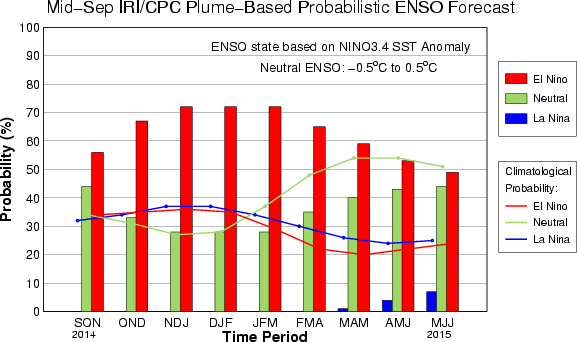El Niño Tracker - Sept 2014
The song remains the same this month with El Niño not quite here yet, but probably soon. This is now the seventh consecutive month since the NOAA Climate Prediction Center issued an “El Niño Watch” last March. The signs are a bit stronger once again, but it is getting late in the game since El Niño events take several months to build up and typically peak during the mid-winter months. Another slug of warm water (known as a “Kelvin Wave”) has been making its way across the Pacific Ocean from west to east just below the surface and is poised to emerge and help warm sea-surface temperatures in the eastern Pacific over the next month or so. There has also been some activity in the western and central Pacific called “westerly wind bursts” which can help move this warmer-than-average water to the east, but the bursts have been temporary and haven’t helped sustain a steady progression towards El Niño conditions.

Forecasts models are predicting the current Kelvin Wave and associated warm water in the east Pacific will finally get this fickle event to organize and roll forward as at least a weak El Niño. The mid-September consensus forecast (Figure 1) issued by the International Research Institute for Climate and Society (IRI) and the NOAA Climate Prediction Center (NOAA-CPC) still indicate a greater than 70 percent chance of El Niño conditions developing during the November-December-January period and most likely persisting through early next spring. Most models indicate that the event will ultimately peak at a weak strength, with only a handful of models suggesting a moderate-strength event. The impacts associated with weak El Niño events are much less certain; past events have brought both dry and wet conditions to the southwest U.S. during the winter season. Seasonal precipitation forecasts still indicate an enhanced chance of above-average precipitation over the upcoming winter season, but confidence in this forecast has wavered slightly because of the expected weak nature of the emerging El Niño event.
This post was originally published as part of the September 2014 Southwest Climate Outlook

